Sunday 2nd January – Nunney, Somerset – New Year’s Day disappeared in a hangover and rain. This morning it is bright but wet. The dogs, Jasper (Peter and Jo’s Wolfhound x German Shepherd) and Dill the Dog trot along the edge of the field. Jasper chases four cock Common Pheasants, but Dill the Dog cannot be bothered and just sniffs at every clump of grass. Jackdaws call from the trees. Periwinkles are in flower from above the big house walls.
Tuesday 4th January – The Fleets – The sun is attempting to brighten a grey day, but seems doomed to failure. A Grey Heron glides in from up the valley and notices another on a fishing stage. It heads in that direction and attracts the attention of Black-headed Gulls. They are not really mobbing the heron, merely being a general nuisance.
Thursday 6th January – Willowbank – It is early morning and not really dark as the glare of lights from the Wakefield Road and Burton Bank half illuminate the area. A Hunter’s Moon hangs low in the sky, crossed by a line of black cloud. There is not a single sound from any bird; even a startled one which flies off from a Hawthorn by the path does so in silence. There is finally a half-hearted song from a Song Thrush which tapers off into silence again.
Friday 7th January – Home – I glance out of the window and notice a mass of feathers on the path. It takes several seconds to realise there is a large female Sparrowhawk in the middle of the feathers feasting on her victim, a Collared Dove. She has one claw on the carcass and tears off gobbets of flesh and then checks around her to see if there are any interlopers. I attempt to get a photograph, but cannot get into the right position and eventually she notices me and takes off with her booty.
Saturday 8th January – Fleets Dam – The wind is a howling gale. There are small branches everywhere. People are actually fishing in these conditions! There is a single Black-headed Gull down the far end, bobbing like a cork in the wind. I soon retreat. A Grey Wagtail is on the car park and seems to wish to avoid flying off into the maelstrom, but eventually Dill the Dog gets too close.
Saturday 15th January – Fleets Dam – The gales died down during the week, but it remained damp and grey. This morning is no different. A Grey Heron flops down onto the lake to grab a fish. This immediately attracts the attention of the Black-headed Gulls and another heron. The first heron flies off around the corner with its prize. Great Tits are active in their pristine plumage. Winter Thrushes seem to have moved on, not surprisingly as there are few berries left around here. Bright green catkins hang from Hazels.
Tuesday 18th January – Fleets Dam – Overnight snow gave the area a thin but consistent coating. Flurries of snow continued throughout the morning, but were turning to sleet by this afternoon. There is little to see on the lake, just a few Black-headed Gulls apparently taking advantage of the cold, buffeting wind to dance on the air.
Friday 21st January – Willowbank – A bitter wind blows across the side of the hill, although it is much reduced in strength from the violence of recent gales. Nothing makes a sound, all preferring to keep low. The sky is lightening in the east; the seasons’ great cycle is moving on.
Saturday 22nd January – Lincoln – A cold and grey day greets us as we head for the city of Lincoln. Lincolnshire is a flat county and with the removal of so many hedgerows, it is a pretty dreary 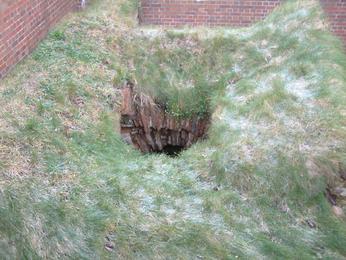 place now. However, as one approaches the city, the cathedral towers above the landscape. The cathedral and old city is built on a hill with the newer parts below, spread across the plain. The Romans built extensively here, firstly a fortress built by the Ninth Legion in 60CE. The remains of a well house can be still seen. The Second Legion, Adiutrix, replaced the Ninth in 71CE and the site became more extensive. In the early parts of the 2nd century CE, a civic centre, the Forum basilica, was developed with an administration centre and probably shops. The Danes settled in the years after the Roman withdrawal from our shores.
place now. However, as one approaches the city, the cathedral towers above the landscape. The cathedral and old city is built on a hill with the newer parts below, spread across the plain. The Romans built extensively here, firstly a fortress built by the Ninth Legion in 60CE. The remains of a well house can be still seen. The Second Legion, Adiutrix, replaced the Ninth in 71CE and the site became more extensive. In the early parts of the 2nd century CE, a civic centre, the Forum basilica, was developed with an administration centre and probably shops. The Danes settled in the years after the Roman withdrawal from our shores.
Lincoln Cathedral – It seems that a church was built here in the 7th century as it is recorded that Paulinus, one of St Augustine’s missionaries, consecrated Honorius as the fifth Archbishop of Canterbury in the little “church of stone” which Bede refers to, some eighty years later as being without a roof. This church possibly stood where the Church of St Paul in the Bail now stands. Paulinus died in 644 and it was four centuries before Remigius began 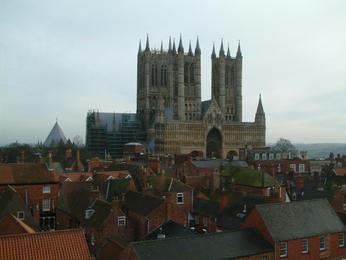 the first cathedral on this site in 1075. On 1141, during the civil war between King Stephen and his cousin Matilda, the cathedral was damaged by fire. A partial rebuilding was undertaken by Bishop Alexander, however an earthquake caused much damage in 1185. It was then that Hugh of Avalon became Bishop of Lincoln. His story is deeply woven with the politics of King Henry II, in whose name St Thomas á Becket had been killed, and the church. Hugh was an extraordinary man who always followed that which he believed to be right which brought him into conflict with the Kings, Henry, Richard and John. However, it is a testament to his popularity with the people that King John was a pall-bearer at his funeral. An interesting story is of St Hugh’s swan. It appears he had a pet Whooper Swan which followed him like a dog. Hugh started rebuilding the cathedral in 1192 in the Gothic style with pointed rather than round arches and another innovation, flying buttresses which took the weight of the walls and roof allowing much larger windows to be created. However, all was not well, not surprisingly given the experimental nature of much of the design, and the central tower collapsed in 1237 or 1239. A new tower was built and the cathedral was enlarged in the mid-thirteenth century. The east end was enlarged to accommodate the increasing number of pilgrims to St Hugh’s shrine. In 1730, James Gibbs added cross walls to strengthen the western towers and spires which had begun to lean. The central tower spire had blown down in 1548 and the spires on the western towers were removed in 1807. Like most cathedrals, the sheer immensity of the building first greets the eyes. One has to recall that it was built without today’s massive cranes, steel scaffolding, power lifts and tools. It is hardly surprising that it would take the entire lifetime of some craftsmen to complete. A becloaked clergyman showed us a number of interesting points. There was a gravestone near St Hugh’s shrine that celebrated a woman who had known 367 of her descendants before she died. A small chapel, the Russell Chantry, contains a mural by Duncan Grant in the 1950s. However, the rather obviously gay inclination of the figures resulted in the chantry being locked for thirty years. Nearby is the tomb of Katherine Swynford, daughter of Sir Payne Roet, and widow of Sir Hugh de Swynford of Kettlethorpe. She had a long affair with John of Gaunt, who was made Earl of Lincoln in 1362, and was for a long time resident in the city and eventually they married. Henry Beaufort, son of John of Gaunt and Catherine, was bishop of Lincoln at the time of his mother’s death, which occurred in 1403. It is interesting to note that much of the stained glass is Victorian, although the great “Eyes” are mediaeval. For much more information, refer to Cathedral
the first cathedral on this site in 1075. On 1141, during the civil war between King Stephen and his cousin Matilda, the cathedral was damaged by fire. A partial rebuilding was undertaken by Bishop Alexander, however an earthquake caused much damage in 1185. It was then that Hugh of Avalon became Bishop of Lincoln. His story is deeply woven with the politics of King Henry II, in whose name St Thomas á Becket had been killed, and the church. Hugh was an extraordinary man who always followed that which he believed to be right which brought him into conflict with the Kings, Henry, Richard and John. However, it is a testament to his popularity with the people that King John was a pall-bearer at his funeral. An interesting story is of St Hugh’s swan. It appears he had a pet Whooper Swan which followed him like a dog. Hugh started rebuilding the cathedral in 1192 in the Gothic style with pointed rather than round arches and another innovation, flying buttresses which took the weight of the walls and roof allowing much larger windows to be created. However, all was not well, not surprisingly given the experimental nature of much of the design, and the central tower collapsed in 1237 or 1239. A new tower was built and the cathedral was enlarged in the mid-thirteenth century. The east end was enlarged to accommodate the increasing number of pilgrims to St Hugh’s shrine. In 1730, James Gibbs added cross walls to strengthen the western towers and spires which had begun to lean. The central tower spire had blown down in 1548 and the spires on the western towers were removed in 1807. Like most cathedrals, the sheer immensity of the building first greets the eyes. One has to recall that it was built without today’s massive cranes, steel scaffolding, power lifts and tools. It is hardly surprising that it would take the entire lifetime of some craftsmen to complete. A becloaked clergyman showed us a number of interesting points. There was a gravestone near St Hugh’s shrine that celebrated a woman who had known 367 of her descendants before she died. A small chapel, the Russell Chantry, contains a mural by Duncan Grant in the 1950s. However, the rather obviously gay inclination of the figures resulted in the chantry being locked for thirty years. Nearby is the tomb of Katherine Swynford, daughter of Sir Payne Roet, and widow of Sir Hugh de Swynford of Kettlethorpe. She had a long affair with John of Gaunt, who was made Earl of Lincoln in 1362, and was for a long time resident in the city and eventually they married. Henry Beaufort, son of John of Gaunt and Catherine, was bishop of Lincoln at the time of his mother’s death, which occurred in 1403. It is interesting to note that much of the stained glass is Victorian, although the great “Eyes” are mediaeval. For much more information, refer to Cathedral
Lincoln Castle – This is a strange affair of a castle. Saxons had built some 160 houses within an old Roman Fort 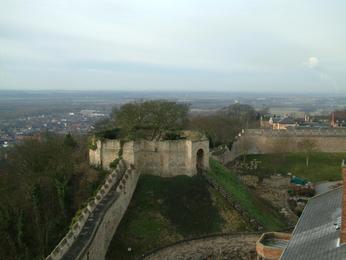 opposite the site of the Cathedral. These were demolished by the Normans and a castle built which dominated the skyline until the Cathedral was completed. None of the Norman buildings within the castle walls remain, but two mottes remain as part of the walls. The larger is called the Lucy Tower after the mother of a 12th century owner, Lucy, Countess of Chester. On the roof there is now a 19th century observatory. This is reached by a long spiral staircase. The view from the top is spectacular, although I remain only a short time as I am somewhat overwhelmed by vertigo! In the area previously occupied by Norman halls, chambers, stables, kitchens etc. there is a 13th century Bishop’s Palace, later the Crown Courts and a Georgian and Victorian prison. The chapel of the prison is preserved, a grim room containing tiers of pews facing a pulpit, with benches to one side behind some fearsome bars. Lincoln’s copy of the Magna Carta is also housed here.
opposite the site of the Cathedral. These were demolished by the Normans and a castle built which dominated the skyline until the Cathedral was completed. None of the Norman buildings within the castle walls remain, but two mottes remain as part of the walls. The larger is called the Lucy Tower after the mother of a 12th century owner, Lucy, Countess of Chester. On the roof there is now a 19th century observatory. This is reached by a long spiral staircase. The view from the top is spectacular, although I remain only a short time as I am somewhat overwhelmed by vertigo! In the area previously occupied by Norman halls, chambers, stables, kitchens etc. there is a 13th century Bishop’s Palace, later the Crown Courts and a Georgian and Victorian prison. The chapel of the prison is preserved, a grim room containing tiers of pews facing a pulpit, with benches to one side behind some fearsome bars. Lincoln’s copy of the Magna Carta is also housed here.
Navenby – The village of Navenby lies on one of the roads south of Lincoln. It lies east of the Roman Road, Ermine Street and there may have been a Roman Posting Station here. It seems an unprepossessing little place, but Rawnsley, in 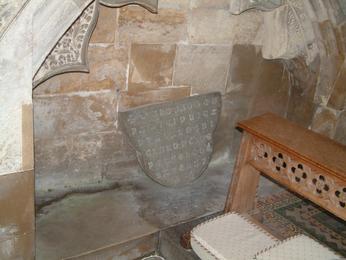 “Highways and Byways in Lincolnshire” (Pub: Macmillan 1914), devotes an entire page to its church. And the Church of St Peter is indeed a splendid building. One has to call at the tea shop to obtain a key. The current church was rebuilt in circa 1320, but one of the 12th century columns was retained and, having a wide circular base, provided the only seating for the elderly and infirm. The chancel is magnificent, almost as long as the nave. In the chancel is a Founder’s Tomb containing a trefoil shaped piece of Purbeck stone. It has an inscription starting with an I H C and ending with an A. It originally read “All ye who pass by here pray for the soul of Richard de Louth 1268-1301 priest of this church”. Closer to the altar is the Easter Sepulchre, containing a ledge where bread and wine would have been placed on Good Friday. Below is a panel containing the figures of Roman soldiers wearing mediaeval costume; it is likely the stone masons had no idea what Roman soldiers actually wore.
“Highways and Byways in Lincolnshire” (Pub: Macmillan 1914), devotes an entire page to its church. And the Church of St Peter is indeed a splendid building. One has to call at the tea shop to obtain a key. The current church was rebuilt in circa 1320, but one of the 12th century columns was retained and, having a wide circular base, provided the only seating for the elderly and infirm. The chancel is magnificent, almost as long as the nave. In the chancel is a Founder’s Tomb containing a trefoil shaped piece of Purbeck stone. It has an inscription starting with an I H C and ending with an A. It originally read “All ye who pass by here pray for the soul of Richard de Louth 1268-1301 priest of this church”. Closer to the altar is the Easter Sepulchre, containing a ledge where bread and wine would have been placed on Good Friday. Below is a panel containing the figures of Roman soldiers wearing mediaeval costume; it is likely the stone masons had no idea what Roman soldiers actually wore.
Wellingore – A village a little further to the South where we lodged in the Marquis of Granby inn. Obviously once a small village it is now expanded considerably with new houses. The old mill has been converted into a dwelling.
Sunday 23rd January – Lincoln – There was a very heavy frost overnight and the small side roads around Wellingore are icy. We search for a Templar tower but fail to find it. We cross Ermine Street which runs straight in either direction. After a while we head back to Lincoln. We wander around the streets of the old city. Between the Cathedral and the Castle is the Bailgate. A splendid half-timbered house stands there, once a bank now in the hands of the Trust. Opposite the street descends down the aptly named “Steep Street”. A little way down stands a Norman House where it is said Aaron the Jew, a money lender in the reign of Henry I lived. This is now disputed. It was also recorded that a Jew called Jopin lived here. He was accused of the ritual murder of a Christian boy – later venerated as “Little Saint Hugh” and laid in a tomb in the Cathedral. The accused and many other Jews were slaughtered and even more imprisoned. The story gained much credence, one hundred years later Chaucer wrote in the Prioress’ Tale –
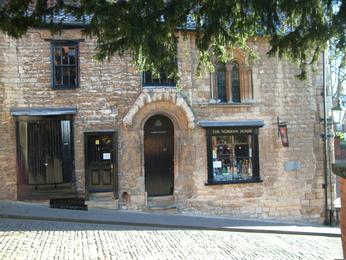
Whilst another lay states:
Whatever happened, anti-Semitism played a great part in this sad affair.
Saturday 29th January – The Fleets – A Mute Swan is feeding at the north end. It is rare to see swans on this lake. Then, even more unusual, a male Shoveler in pristine plumage, dark bottle green head and a rich chestnut patch on its flanks, swims out from the edge. It is the first time I have seen this species here.